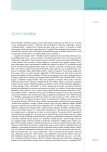Treatment of neurogenic detrusor overactivity using botulinumtoxin A – initial experiences with submucosal route of application
Authors:
Vladimír Šámal
Authors‘ workplace:
Urologické oddělení, Krajská nemocnice Liberec, a. s.
Published in:
Ces Urol 2011; 15(2): 108-112
Category:
Original article
Overview
Aim:
Treatment of neurogenic detrusor overactivity using botulinum A toxin is the first option for patients refractory to antimuscarinic drugs. This study compare changes of urodynamic parameters in different route of application of botulinum A toxin – submucosal and intramuscular.
Material and methods:
Twelve patients after spinal cord injury in age between 16 and 36 year were randomised into two groups to receive 300 U of Botox® by cystoscopic approach. In group A was drug administred submucosaly and in group B into detrusor.
Results:
Author present preliminary results of 12 patient. After treatment number of epizodes of incontinence decreased in about 69% in group with suburothelial application and in about 53% in group with intramuscular application. Maximal cystometric capacity increased from 230 ± 78 ml to 435 ± 107 ml in group with submucosal application and from 229 ± 91 ml to 410 ± 72 ml in group with application into detrusor.
Conclusion:
Application of botulinum A toxin in period 3 month after treatment increase maximal cystometric capacity and decrease detrusor pressure during first involuntary detrusor contraction. From this initial preliminary results the both route of application seems to be comparable.
Key words:
botulinum toxin, detrusor overactivity, incontinence.
Sources
1. Leippold T, Reitz A, Schurch B. Botulinum toxin as a new therapy option for voiding disorders: current state of the art. Eur Uro 2003; 44: 165–174.
2. Dong M, Yeh F, Tepp WH, et al. SV2 is the protein receptor for botulinum neurotoxin A. Science 2006; 312: 692–596.
3. Haferkapm A, Schurch B, Reitz A, Krengel U, Grosse J, et al. Lack of ultrastructural detrusor changes following endoscopic injection of botulinum toxin type A in overactive neuorogenic bladder. Eur Urol 2004; 46: 784–791.
4. Patel A, Patterson J, Chapple C. Botulinum Toxin injections for neuorogenic and idiopathic detrusor overactivity: A critical analysis of results. Eur Uro 2006; 50: 684–710.
5. Kuo HC. Comparison of effectiveness of detrusor, suburothelial and bladder base injection of botulinum toxin A for idiopathic detrusor overactivity. J Urol 2007; 178: 1359–1363.
6. Karsenty G, Denys P, Amarenco G, et al. Botulinum toxin A (Botox®)intradetrusor injections in adults with neurogenic detrusor overactivity /neurogenic overactive bladder: a systematic literature review. Eur Urol 2008; 53: 275–287.
7. Krhut J, Kopecký J, Hradílek P, Zapletalová O, Tvrdík J. Výsledky léčby neurogenních dysfunkcí dolních cest močových aplikací botulinumtoxinu do detruzoru. Čes Urol 2007; 11(3): 154–158.
Labels
Paediatric urologist Nephrology UrologyArticle was published in
Czech Urology

2011 Issue 2
Most read in this issue
- Lichen sclerosus – commonly overlooked urological diagnosis with serious complications
- Neural control of the lower urinary tract
- Impalpable testis, what first: diagnostic laparoscopy or inguinal exploration?
- Carbonic anhydrase IX (CA IX) expression in renal cell carcinoma and transitional cell carcinoma of urinary tract
